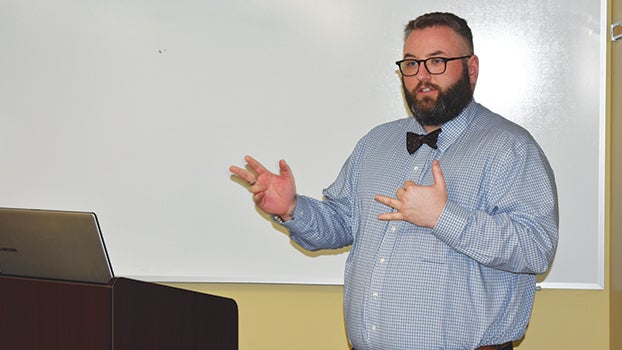Rotarians learn about SMC student housing
Published 7:52 am Friday, April 12, 2019

- Jeff Hooks, director of residence life at Southwestern Michigan College, gives a presentation about student housing to the Dowagiac Rotary Club. He explained the benefits of campus housing, the difference between dorms and residence halls, and what sets SMC residence halls apart from other colleges’. (Leader photo/ADAM DROSCHA)
DOWAGIAC — As lunch forks clinked against plates and the chatter of the week’s events ebbed and flowed in the back-conference room of Front Street Crossing, Jeff Hooks, the director of residence life at Southwestern Michigan College, might have wondered what the room of mostly older Dowagiac Rotarians would find interesting about his upcoming presentation.
His presentation at the regular Thursday meeting of the Dowagiac Rotary Club about student housing at SMC, however, would spark interest and a dozen questions from the club’s members.
“National studies indicate that students that live on campus are satisfied with their living environment,” Hooks said. “It’s been shown that living on campus at a residence hall impacts a student both academically and personally more than anything else in college, except for the specific classes they’re in, so there is an academic and personal impact on students that live in campus housing.”
Hooks began his presentation expounding on some of the key points and benefits for college students to live on campus. Building off his reference to national studies, Hooks said students who live in residence halls are more likely to graduate and enter graduate school, meet more diverse people, develop strong interpersonal skills, finish college in less time, have more contact with faculty and have higher self-esteem.
There are all kinds of stigmas, stereotypes and negative connotations of college dorms. In some minds, dorms might appear messy, smelly or prison-like. Images of rabble-rousing, tomfoolery and petty arguments might also come to mind because of past experiences or stories. Hooks debunked many of those mental images beginning with the term “dorm.”
“We don’t call residence halls ‘dorms’ any longer,” Hooks said. “The main reason for that is dorms are just places for people to go and sleep, and that’s all they do there. If you look up dorm in the dictionary, that’s exactly what it says. Whereas at a residence hall, we provide programming, tutoring, socializing, counseling, emotional support, opportunities for students to pick up leadership skills and just opportunities to grow and develop as a person.”
Hooks spent some of his presentation outlining several of the programs and activities SMC residence halls have to keep students engaged communally, including midnight breakfast, group outings and residence hall traditions. His examples, he said, show there is a significant difference between having a place to sleep and having a place to interact with others.
Hooks also took time to explain many of the benefits of campus living at SMC. Everything from the size of the residences, the kitchen space, the lack of a curfew, the coed halls, and especially the quality and cost of the living spaces make SMC’s campus housing well worth consideration, he said.
“These are the nicest [residence halls] on any college campus I’ve ever worked on, and I’ve worked at colleges with 30,000 students,” Hooks said. “These are super nice. They’re very well kept.”
Hooks’ sentiment was echoed by one Rotarian, Larry Crandall, who saw the residence halls up close.
“It was amazing, I’ve never seen dorm rooms like that,” Crandall said. “They’re absolutely amazing and [building residence halls] has proven to be a good decision.”
Hooks further ellaborated on the exceptional residence halls at SMC by pointing out that most colleges with a two-year emphasis do not have housing at all. SMC currently has three residence halls, McKenzie, Jerdon and White that split students according to their interests and academic emphases, though all of the buildings provide full access to all students.
For more information about SMC student housing, readers can visit swmich.edu/housing






